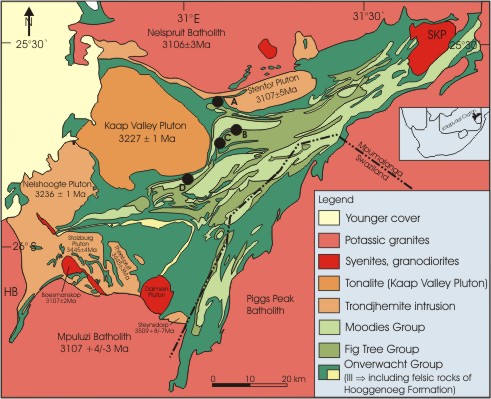
The Palaeoarchaean sea may not have been a scalding, lifeless sump, if a new model based on revolutionary new analytical methods is to be believed. But is it? Harriet Jarlett* investigates.
Geoscientist Online 6 May 2010
The early Earth (Palaeoarchaean 3.5Ga) had, until recently, been thought of as inimical to life, with ocean temperatures of up to 85oC and an atmosphere consisting mostly of methane. However, controversial new evidence from Blake et al. using revolutionary new phosphorus-measuring techniques, suggests that Palaeoarchean oceans were not only temperate - at a mere 40oC - but even biologically productive, with a highly developed biological phosphorus cycle1.
The South African Barberton Greenstone Belt consists mostly of volcanic rocks inter-layered with minor sedimentary units, including cherts, banded iron formations and variably silicified terrigenous and volcaniclastic sediments. The origin of the cherts has long been disputed, but the ratio of 18O to 16O isotopes in them and their co-existing sedimentary phosphates have been the subject of intense interest because oxygen isotopes can be used as a palaeo-thermometer.
Biological processes concentrate phosphate in modern, low-temperature marine environments, and modern marine phosphates have typical δ18OP values typically between 19 and 26‰. The new analytical methods used by Blake et al. put the isotope ratios in Barberton phosphates at 9.3-19.9 ‰, suggesting that the Archaean Ocean had an ambient temperature of between 26-35oC - not too far from the 25-30oC of our modern day, life-sustaining oceans.
One of the biggest arguments favouring a much hotter Archaean ocean centres on the high temperature required to dissolve silica in water. Clearly, the joint occurrence of apparently cool-precipitated phosphate and hot-precipitated chert is hard to reconcile. However, Blake et al. suggest that the reason previous researchers estimated such warm ocean temperatures is because the phosphates and cherts formed by two different processes on the Palaeoarchaean sea bed. According to them, “high phosphate δ18OP would record low-temperature biological processing - in equilibrium with cooler surface waters - while some chert δ18OP values could record warmer seafloor conditions”, under the influence of hot springs, belching hydrothermal fluids.
Low temperature biological processing could even, the authors suggest, represent an exchange of oxygen resulting from enzymatic catalysis - opening the possibility that the ocean chemistry was being mediated by microbial metabolism. In other words, they suggest that microbes had developed and were promoting evolved phosphate cycling much earlier than many estimates for the origin of life on Earth. Barberton chert is also currently the source of much attention at the EGU meeting in Vienna, where researchers have announced that they have pushed back the time at which the Earth first developed a magnetic field – an event that would also have facilitated the origin of life.
This paper remains highly controversial as it contradicts previously accepted evidence that the early Earth was far warmer than today. Professor Paul Knauth, who co-wrote the definitive paper on Barberton Cherts as evidence for a hot early Earth2, think Blake et al. may be have prematurely announced findings based on methods that are as yet not fully proved. Knauth told Geoscientist that he considered the paper “flawed” and planned with others to submit a critical comment next month. However, even their research did uncover some cherts that gave lower, 40oC temperatures (although they attributed this to anomalous weather conditions).
The new ideas put forward by Blake et al. are an interesting development in Palaeoarchaean research. However, it is likely, that, until their analytical methods become better established and more widely accepted, the Earth's ancient ocean will still be thought of by most as sizzling and barren, rather than the balmier habitat Blake et al. envisage.
References
- Ruth E. Blake, Sae Jung Chang & Aivo Lepland 2010: Phosphate oxygen isotopic evidence for a temperate and biologically active Archaean ocean. Nature Vol 464 15 April 2010 doi:10.1038/nature08952.
- Knauth, L. P. & Lowe, D. R. High Archean climatic temperature inferred from oxygen isotope geochemistry of cherts in the 3.5 Ga Swaziland Supergroup, South Africa. Geol. Soc. Am. Bull. 115, 566–580 (2003).
*
Harriet Jarlett is an MSci student at University College London and working as an intern on Geoscientist.